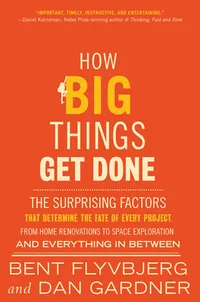
How Big Things Get Done
We’ll get insightful information from Bent Flyvbjerg into the world of big projects, what makes them and what breaks them.
The book goes through some examples and we get to see certain patterns scattered throughout all the projects that fail and those that succeed.
One of the first is the planning and execution. A short amount of time spent on planning and jumping straight into execution seems to be a recipe for disaster and fat-tailed projects.
This is a simplification, but it works: first, planning; second delivery.
Think first, then do
A project begins with a vision that is, at best, a vague image of the glorious thing the project will become. Planning is pushing the vision to the point where it is sufficiently researched, analyzed, tested, and detailed that we can be confident we have a reliable road map of the way forward.
the mighty Caesar Augustus, whose personal motto was “Festina lente”, or “Make haste slowly”
People say that projects “go wrong”, which they all too often do. But phrasing it that way is misleading; projects don’t go wrong so much as they start wrong.
If “Think slow, act fast” is the wise approach to big projects, why do so many people do the exact opposite? Because they rush to commit. You do need to commit. But not in the way you think.
Taking a longer time to plan is actually a good thing. It gives you time to think things over, find different approaches, figure out edge cases before you get to them, create smaller-scale iterations for the project, and improve on those based on feedback.
Getting started right away might feel like you’re going to make so much progress by not wasting time on planning and actually tackling the issues, but you’re not.
You’re just blindly diving headfirst into an unknown set of issues that might require you to backtrack and redo work or even start over altogether.
You want the flight attendant, not the pilot, to be an optimist.
To generate snap judgments, the brain can’t be overly demanding about information. Instead, it proceeds on the basis of what Kahneman calls “WYSIATI” (What You See ls All There Is), meaning an assumption that whatever information we have on hand is all the information available to make the decision.
This simple distinction applies in most fields: whatever can be done in planning should be, and planning should be slow and rigorously iterative, based on experiri.
Try, learn, AGAIN. Whatever the project or the technology, it’s the most effective path to a plan that delivers.
When you’re talking about estimates and delivery, Bent Flyvbjerg mentions two important things: experience and reference class forecasting.
Experience in the same field or on similar projects will increase the level of accuracy of the project, and it will help you identify the correct anchor to use for estimating the project.
You get the correct anchor by using something called reference class forecasting: similar projects that you can relate to in order to build your own expectations.
As much as we like to think our project is unique, one of a kind, that is not true, and it’s a trap that will result in a fat-tailed project (costs and time) if you don’t use reference class forecasting.
Experience is invaluable.
Aristotle said that experience is “the fruit of years” and argued that it is the source of what he called “phronesis” - the “practical wisdom” that allows us to see what is good for people and to make it happen, which Aristotle saw as the highest “intellectual virtue”
To create a successful project estimate, you must get the anchor right
What makes the reference class the right anchor is what I emphasize in the previous chapter: relevant real-word experience.
But it’s dead wrong. Early delays cause chain reactions throughout the delivery process. The later a delay comes, the less remaining work there is and the less the risk and impact of a chain reaction.
Lost ground can always be regained - lost time never
Modularity is king when it comes to delivering projects on time and within budget.
Get your project, break it into smaller parts, identify the smallest that can be built and reused. Get those small parts completed, assemble them as you need, and scale the project this way, not as one big thing that is unique.
Modularity delivers faster, cheaper, and better, making it valuable for all project types and sizes.
Solar power is the king of modularity.
The pattern is clear: Modular projects are in much less danger of turning into fat-tailed disasters. So modular is faster, cheaper, and less risky. That is the fact of immense importance.
When possible, hire a masterbuilder. And masterbuilder’s team.
It’s a very good read, and I recommend it to anyone that is doing any project management work or is about to start a project.
Even if you’re going to just remodel the kitchen, the approaches in it are ideal, as the book demonstrates in the first pages.
Description
This description is grabbed from Google Books or GoodreadsThe secrets to successfully planning and delivering projects on any scale—from home renovation to space exploration—by the world's leading expert on megaprojects. Full of vivid examples ranging from the building of the Sydney Opera House, to the making of the latest Pixar blockbusters, to a home renovation in Brooklyn gone awry, How Big Things Get Done reveals how to get any ambitious project done—on time and on budget.